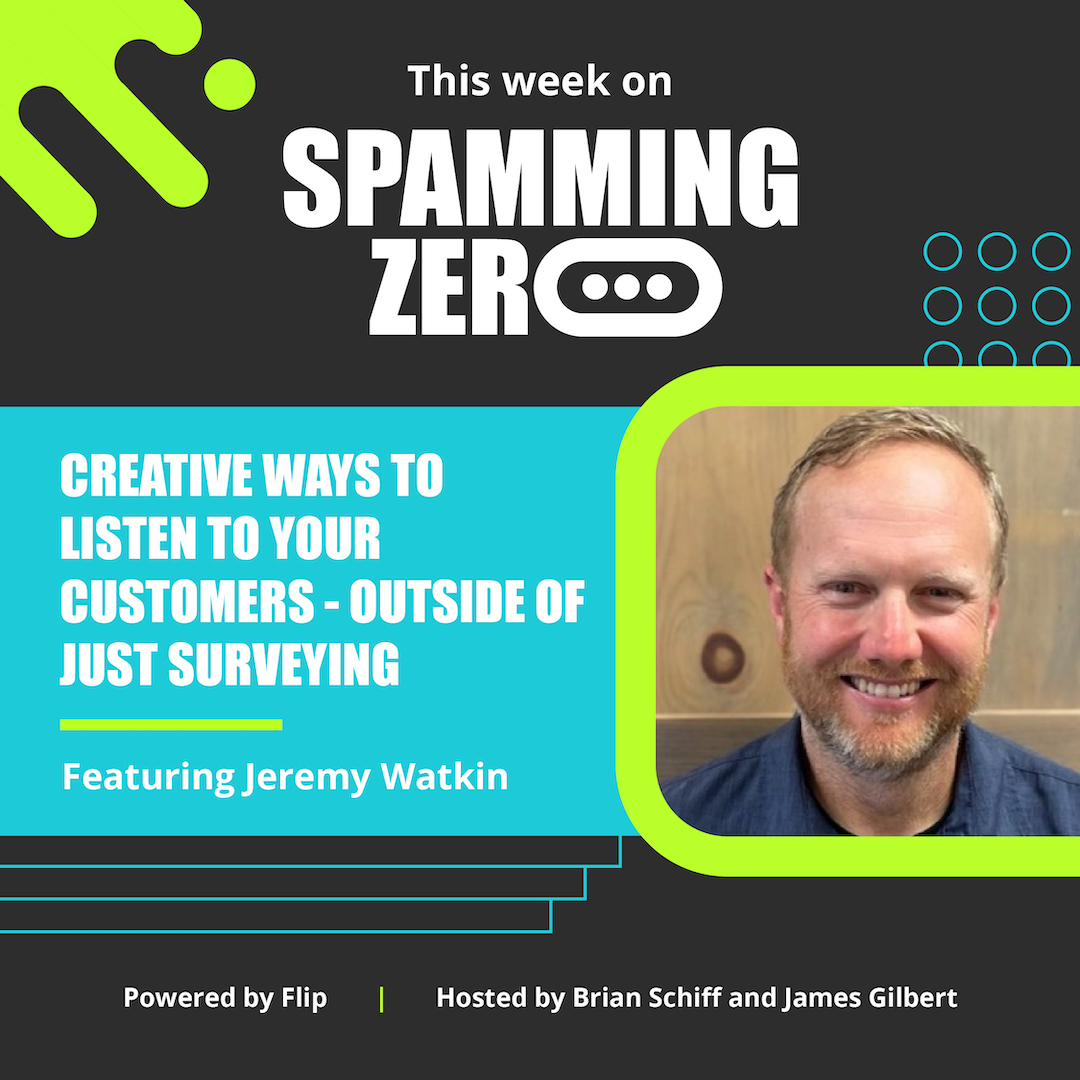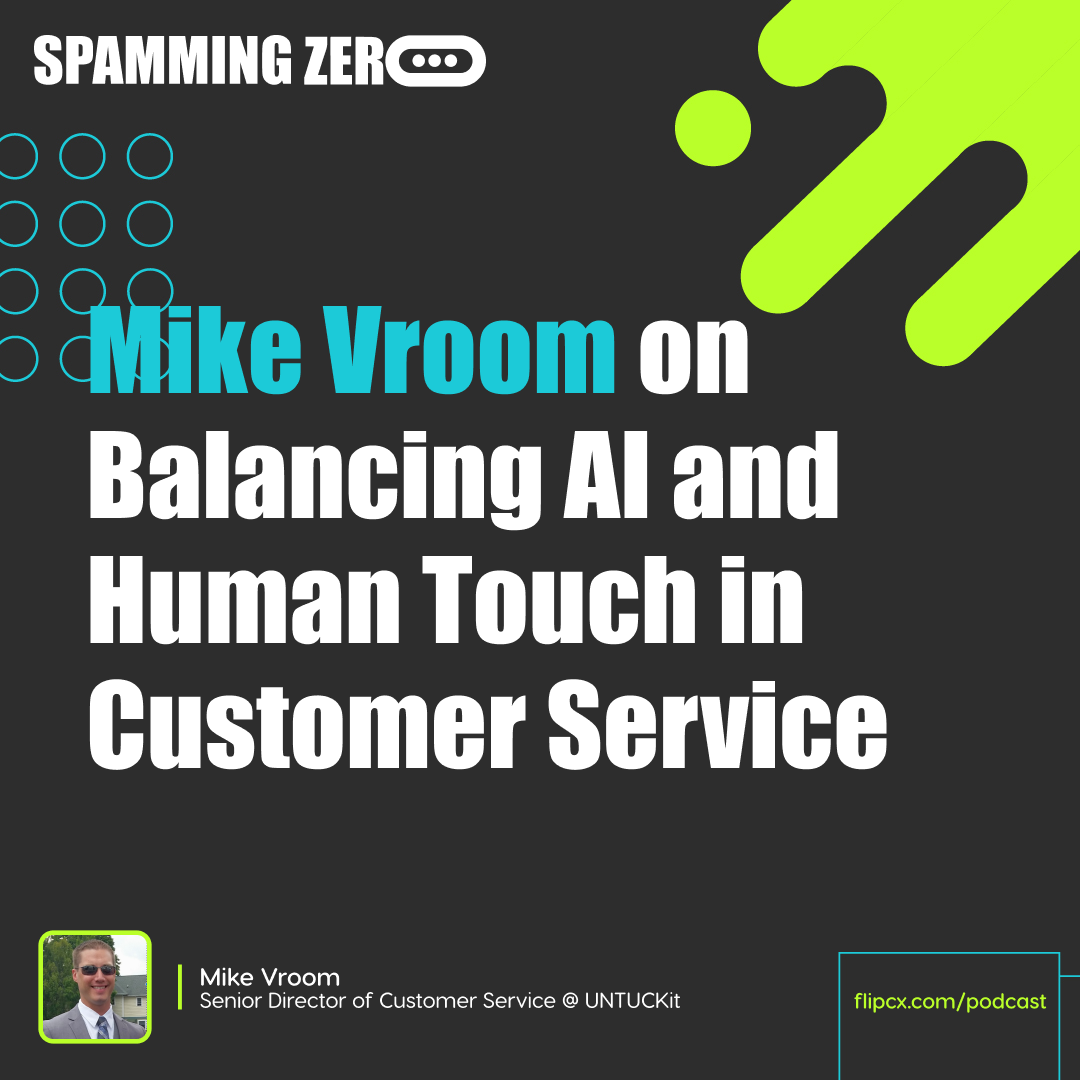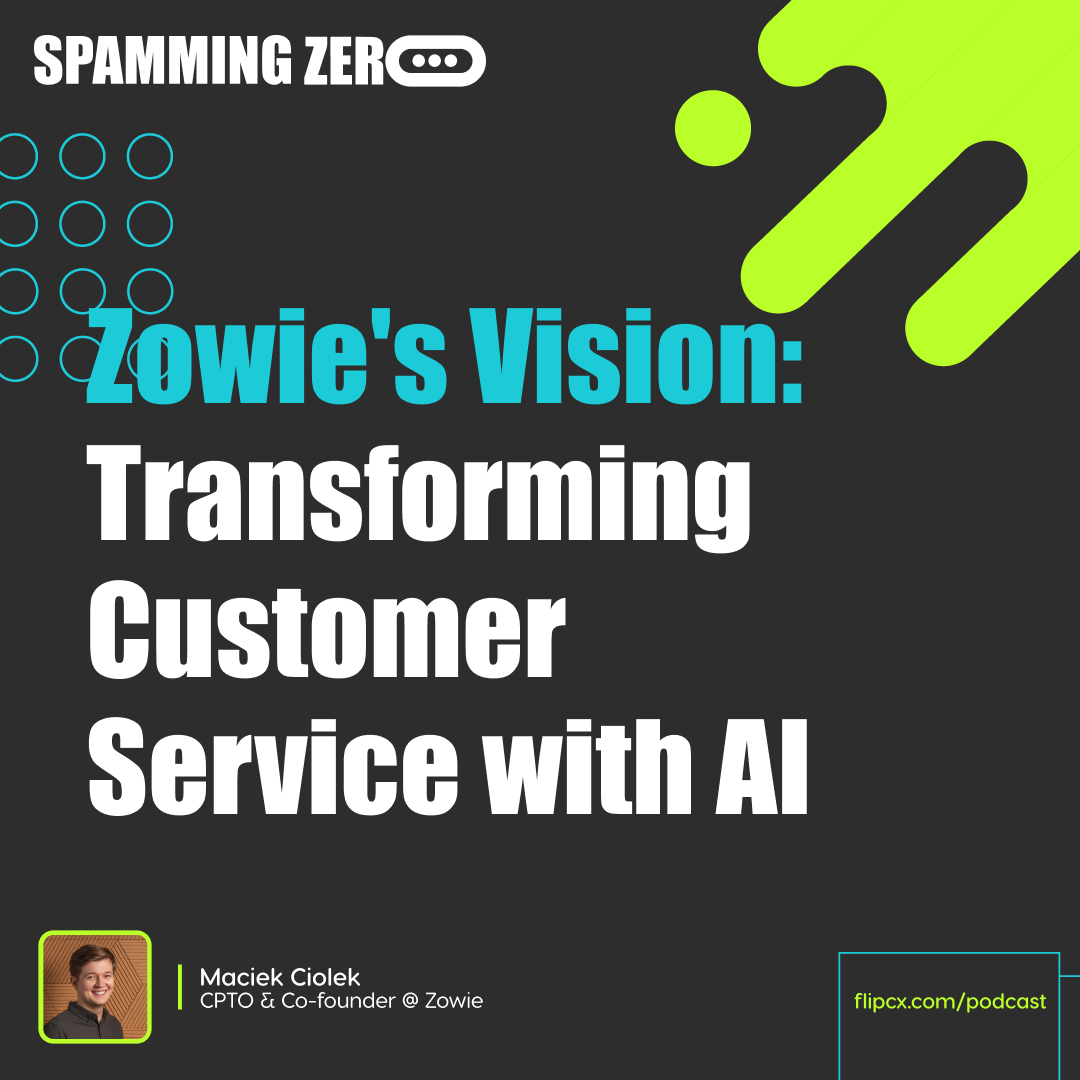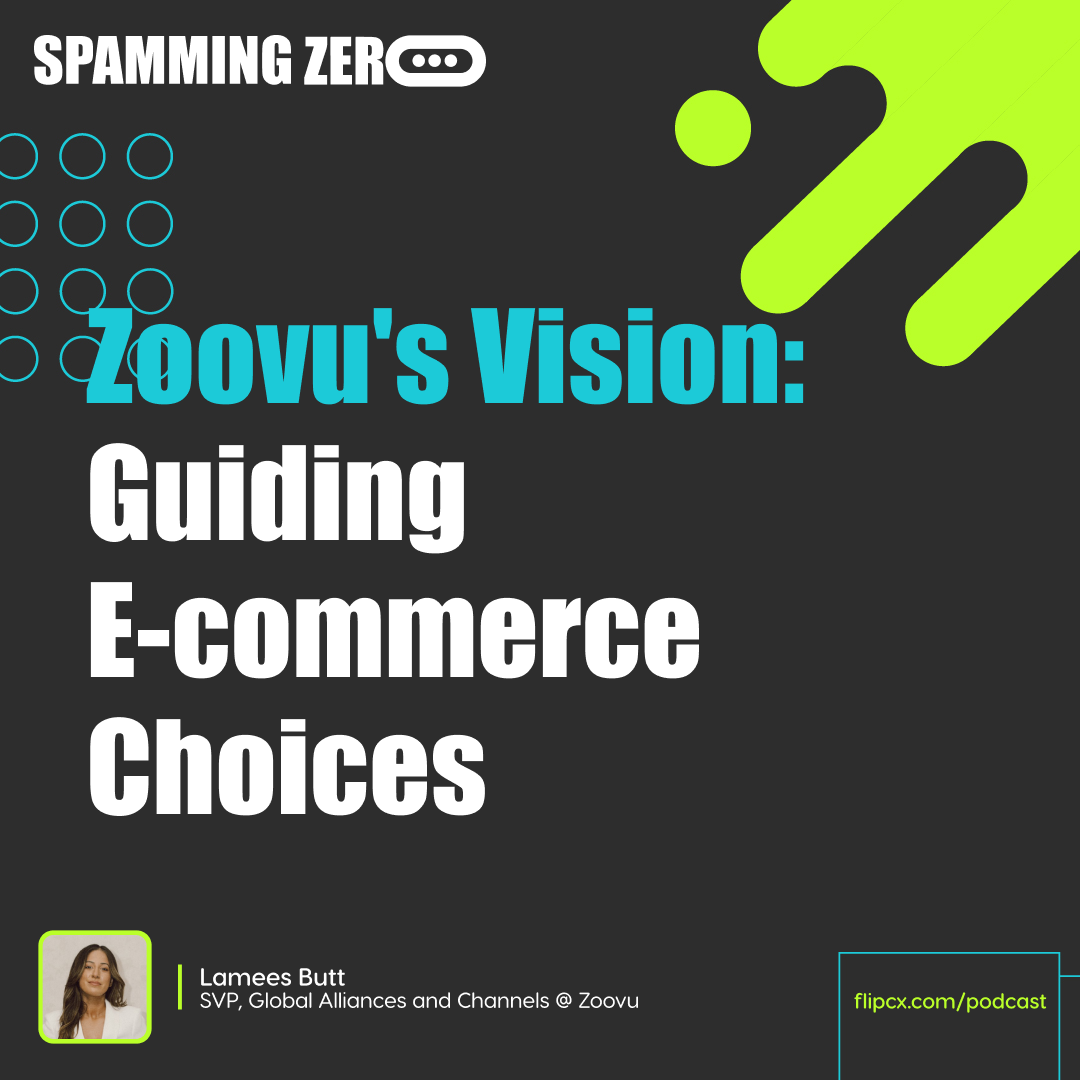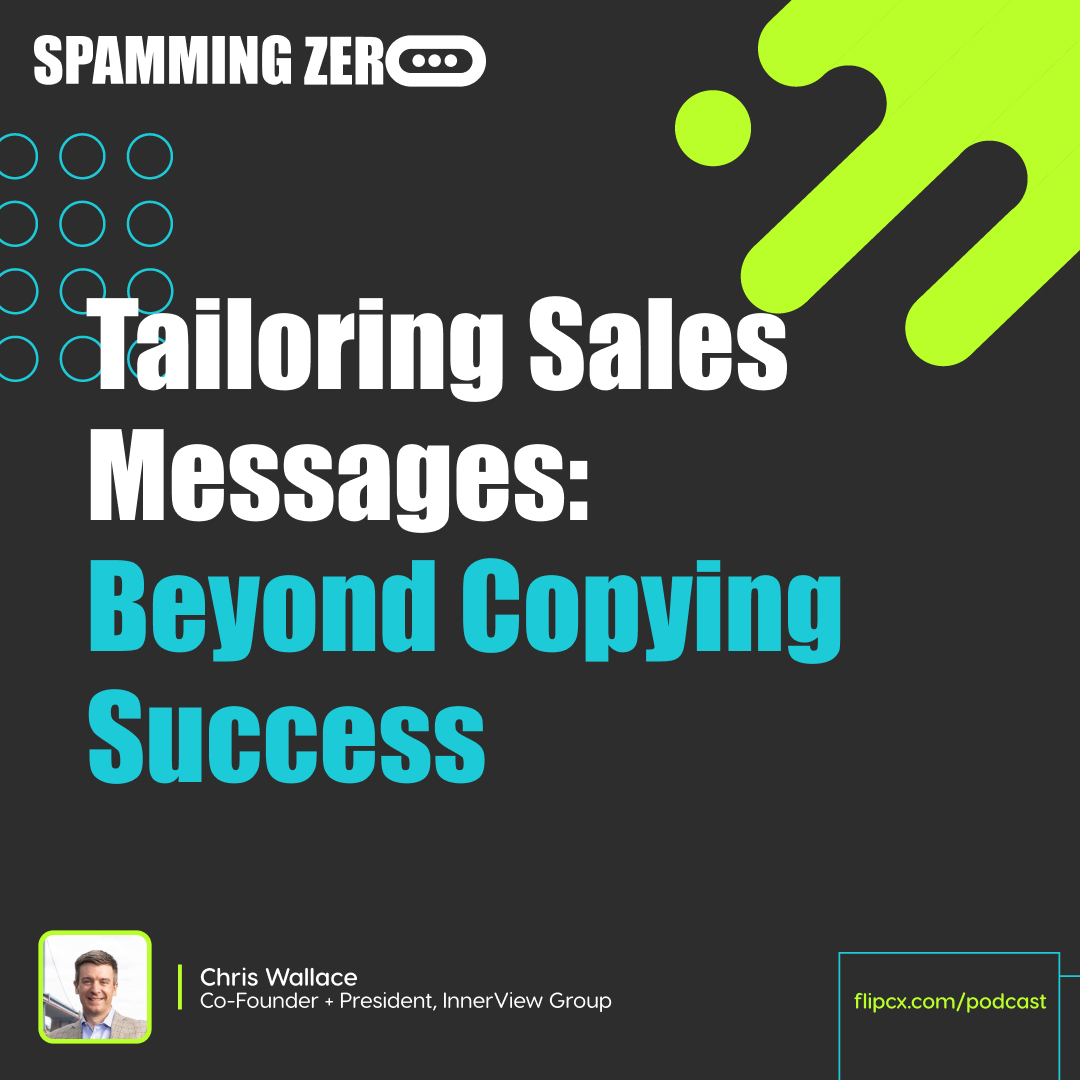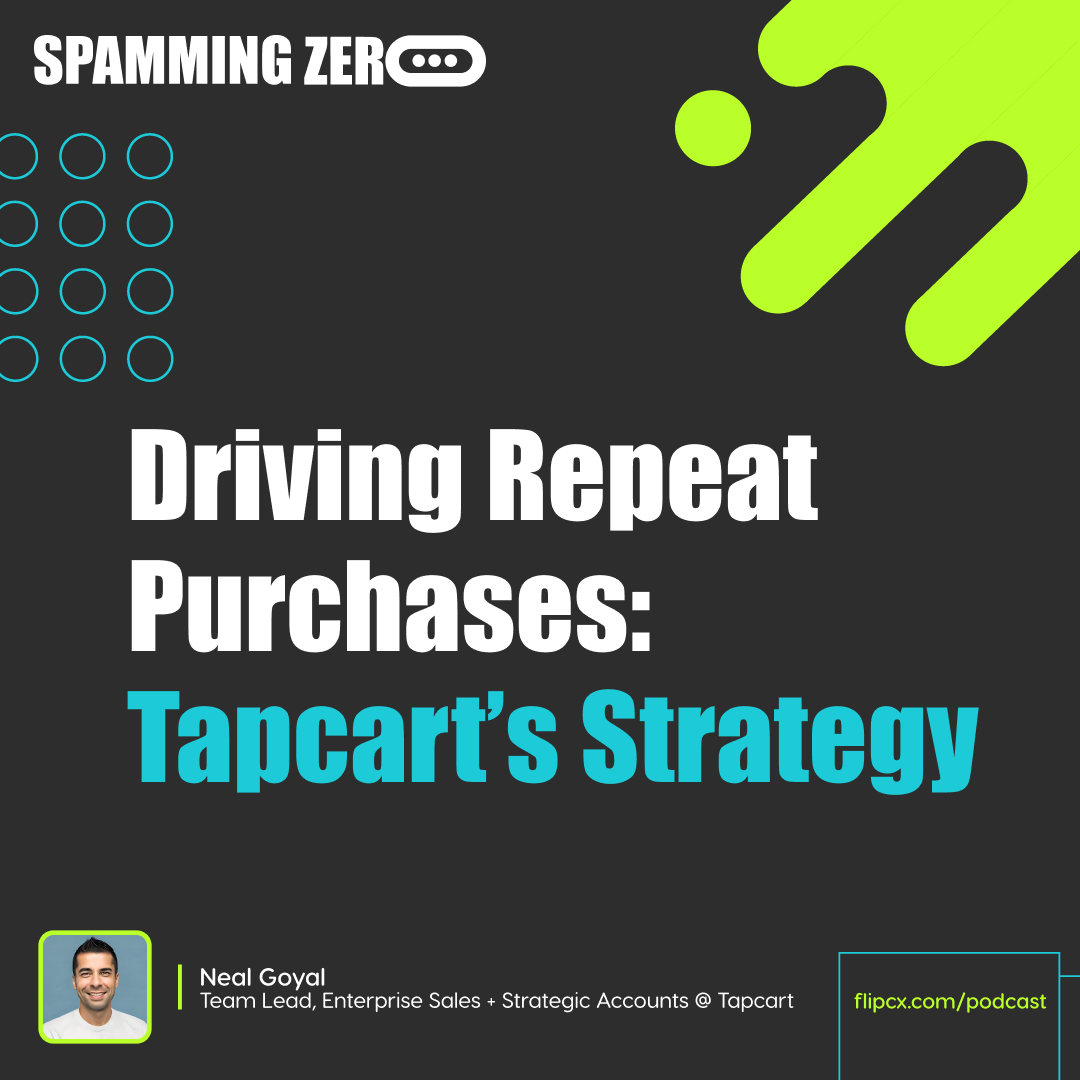Episode 28: Beyond Surveys - Creative Ways To Listen To Your Customers
- 0.5
- 1
- 1.25
- 1.5
- 1.75
- 2
James: Hello everybody. Welcome to another episode of Spamming Zero. I'm your host James Gilbert, along with Brian Schiff. Super excited about this episode today. We're just a couple weeks away from one of the big holidays of the year and in the thick of peak season. And so it's fitting that we are joined by Jeremy Watkin. He is the director of customer experience and support at Number Barn. If you're not familiar with Number Barn, go check them out, especially for all the brands out there that, I don't know, maybe need to bring back their phone number. That's a good idea. Chief Experience Officer at CX Accelerator. Awesome community. If you're a CX professional, I highly recommend you check it out. He has more than two decades of experience as a customer experience and contact center professional leading highly engaged teams. Jeremy has been recognized numerous times as a thought leader of his writing, speaking, and a variety of topics including quality management, customer experience, contact center, and more. When not working, you can find typically he is spending time with his wife, Alicia and their three boys, running with his dog, or dreaming of native trout raising for a size of a 16 elk hair caddis. I don't know what that is. Oh my goodness. That's like a foreign language to me. I need to learn what that is. Be sure to connect with him on Twitter and LinkedIn. He is an awesome person to know, learn from. He has these really fun Twitter threads also that are great to be a part of, that are just really engaging. So looking forward to talking about contact center and talking about a lot of the different ways in which he has approached things in his career when it comes to customer experience. Stay tuned. We'd like to thank this month's sponsor LTV Plus. They are a customer service outsourcing partner. LTV Plus provides world class customer service, outsourcing to help e- commerce brands increase their customer lifetime value. We fully believe in that. We recruit and train agents from all over the world to give your e- commerce business the right people skills and language for success. Part of their mission is to rid the world of bad customer experiences. Part of their vision, increase the customer lifetime value of e- commerce brands. Love what they do. They're also a very important part of our ecosystem. Check them out, ltvplus. com. I'm James.
Brian: And I'm Brian.
James: And this is Spamming Zero. Welcome to the show, Jeremy. Give the audience a little bit of why customer experience matters to you so much.
Jeremy: Well, I think for me, my background is in the contact center working for software companies. I spent, at least, it's the first thing I did out of college and I spent the first decade, whether I was on a support team or managing and leading support team, spent that time trying to figure out what I was going to do with my life. And because I know I didn't want to sit on the phone and get yelled at. And furthermore, when customers would yell at me, I thought they were yelling at me. I've read up on emotional intelligence and that has helped me immensely. But I think customer experience I think just gave me a lot of meaning and helped me realize this can be a career. There's a lot to be said about careers where you're serving others and helping them. But also I'm really starting to geek out over the whole realization that maybe customers don't actually want to call us, maybe they don't want to email us. Maybe there's some things I can do by looking at analytics, looking at reasons customers are contacting us and finding ways to fix those things without them. A big revelation, too, about customer experience is that it's customer experience is this giant pie and customer service is one piece and it's really the piece that we eat when everything else breaks down. I've really enjoyed the evolution out of just answering call after call to really thinking about the big picture and how we can impact the customer experience from all angles.
James: So Jeremy, you have recently spoke quite a bit about a particular topic that I'm excited to dive into on this episode and that's more creative ways in which you can listen to customers outside of just surveying them. So this is something that I am particularly all on board for, because a survey is such a small data point and a moment in time and I think there's way too much clout put into those surveys and the results of those surveys versus maybe some of these things that I want you to dive into. So let's dive into the topic. What are some of the areas that you feel like, what are the top three or four that you think people should try to do or brands should try to do outside of surveying?
Jeremy: Well, yeah James, I think one thing you have to consider with surveys, I know ours is integrated with our ticketing system, so we do get a decent response rate, which is 15 to 20%. And that you realize that's 80% of tickets you potentially aren't hearing from and what are those about? So I think tools like speech analytics and whatnot can help you tap into what those other interactions are about. I don't actually have that. So when I presented, I talked about other creative ways we're trying to figure out what customers are saying. One of mine that, and this involves my whole team, but I really wanted to zero in on the things customers are asking for that we can't do or that we're having problems doing. Things, and you guys are a software company as well, but what feature requests are our customers asking for that we don't have? What bugs are they servicing? And then where are the opportunities where we are cross- selling and upselling to our customers? So I have our teams tagging those things and then we're regularly looking into those. And the cool thing about that, I think just a couple things. We're able to, from the contact center customer support side of things, able to tell our product team, " Here are the top feature requests we're constantly getting asked for." And I have a list of a few hundred, but they're definitely some that have surfaced to the top and I think they've helped our product team. And then on the upselling side, you can look at our upselling attempts and see which ones actually converted customers and that helped our marketing team around some pricing decisions and whatnot.
Brian: What sort of trends did you find in that?
Jeremy: The upselling side of things?
Brian: Yeah.
Jeremy: Well part of it went back to features that we don't offer on what product that we do offer on another. So it helps us understand what features customers are really looking for. I work at Number Barn, we're a number management company and customers want things like advanced text messaging. We actually acquired a company called String that can do that. But then it's like, how can we make that appealing enough to get them to convert over to String?
Brian: How do you weave upselling into the workflow? I assume you don't have your agents on every single conversation trying to upsell. So how do you think about the triggers and weaving it in?
Jeremy: We're newborns in that process, to be honest. My philosophy as a support leader, I'm not a sales guy, so I want my team to be focused on solving problems and part of solving the problem is presenting a solution that can help them, great. We are just getting into, and this is mostly over email, but giving our team blurbs that they can insert into emails to say, " Hey, have you heard about this other product? I think it would be a great fit for what you're doing."
James: I'm curious with your background, especially running support teams and running contact center teams and we're in the thick of peak season for many, many T2C brands and I'm genuinely curious about this question whenever I speak to somebody that's had a ton of experience in that space. What's the number one thing that you think about right now during peak season? If you're running a team, what's the number one thing you think about?
Jeremy: Well, being on a small team, the number one thing I think about is, how many emails am I going to have to do today? How many customers am I going to have to interact with? And we've had a busy week. Our seasonality is weird. With telephone numbers, we're kind of synced up with Cyber Monday a little bit because people are getting devices and want to upgrade their telephone number. I am thinking a lot and trying to grow in this area of just like, I think we're going to have a busy day today, but how busy is this going to be? Can I look at our past data to predict what today and what this week and this next month is going to look like? I think I'm getting better at it, but it's a constant challenge. And then I think on a more personal level, it's hard to recruit and train customer service folks and at the burnout level is really high. And so I want to also just focus on caring for our team and caring for my manager. It's just a busy time and people get stressed out. And so making sure my team is cared for and doesn't feel like we're just riding them till they burn out. Those are kind of the three things that come to mind.
James: How would you mesh these two topics together? So let's do a little bit of that. When we're talking about creative ways to listen to customers outside of surveying, how do you empower a customer support team and agents, for example, to do that more so on the front line rather than you as a manager who's on the backend looking at a lot of the data? How would you also empower your agents to do that?
Jeremy: It's like, it's not voice of customer, but it's voice of agent. It's funny, I've worked in contact centers and I worked at a BPO where literally you're sitting on the contact center floor and people are just taking calls all day long. And the typical flow is somebody gets a call, it's something's clearly broken, they turn around to their neighbor and say, " Hey, how many calls have you had about this issue?" And then it kind of spreads through the contact center. You just hope it makes it to the manager or the center director so they can raise the issue up the flagpole. And it's so interesting to contrast that environment that I've been in to an environment where people are on Slack or Microsoft Teams and you're just begging your agents to not just take call after call or pound out email after email, but pause and go, " Something's not right about that interaction I just had. Maybe I should tell somebody about it and maybe I should see if anybody else on my team is having this issue." And I know anytime the contact center agent gets on Slack and starts typing, they run the risk of somebody being like, " What are you doing messing around on Slack when you should be interacting with customers?" I just want to encourage anybody working in a contact center, running a customer support team to be careful on squashing the chatter that happens on Slack or Teams or whatever your collaboration tool. That's a huge point of listening to your customers and your agents to knowing what's going on, what's driving your volume at any time.
Brian: There's a little bit of the, you get what you measure. And if the measurement is handle time and tickets and calls per hour and it's all about velocity and efficiency, then you're at a metric level incentivizing people to not take those behaviors. So how do you balance that?
Jeremy: Man, yeah, you don't want to... Well I think the first thing I look at, we do have some team metrics as far as how much volume you crank out, but you got to balance it with quality. And you got to be careful to separate team goals from individual goals. I'm looking at productivity on one side, but I'm also having conversations about the quality of your interactions. I would rather have somebody with high quality than high productivity, but we're looking for the balance for sure.
Brian: So you mentioned that you're focused on learning from these interactions, but that you have not taken the dive into a speech analytics solution, which there are a lot of at this point. What's the thinking there?
Jeremy: We're not really doing phone support right now, so that's part of it. And I know some of this is on me from past experiences is just being able to prove that solution is going to pay for itself in insights. And we're just dabbing into it in our ticketing system where we're starting to get smarter about routing, and that that's key. You got to be able to route, you got to help customers self solve more and more. And I think, I will say personally, I know I mentioned speech analytics, but if there was a text analytics tool out there that I could plug into Zendesk, that'd be pretty sweet.
James: I always find it interesting because the frontline agents are typically the first ones to get the problems of where something happened and they're the first ones to deal with this. So to your point, trying to aggregate all of the information that's coming in on a day- to- day basis when something could be timely wrong and it could only be that day that it's wrong and escalating that up. And it makes me think about how important it is to have this mind share and the data consolidated in a single place for everyone to be able to see. How often were you dealing with an aggregated form of data where these things when they were escalated could be recorded and managers can actually see, " Hey, this has occurred 30 times over the last two hours. I think we have a big problem and this needs to be escalated."
Jeremy: Well, I'd love to say I have this fully dialed in.
Brian: Love the honesty.
Jeremy: In past environments where I was on the phone, it's almost a luxury when you can see the phone queue blow up because you know there's an obvious issue. When you're in email, sometimes you can see the queue blow up, but I think that tends to enhance the delay a little bit. But the ones that really keep me up at night are the subtle issues where you're getting 5, 10 tickets a day and it goes on for a couple weeks and then our CTO says, " Hey, we just discovered something was broken. Why didn't you guys tell us about it?" And I'm like, " My bad, we missed it. It wasn't in our obvious signals." We look at our ticket volume every day and that didn't spike. But in hindsight I can see that we did have a little bit of a bump in ticket volume because whatever this bug was introduced on our last release or something like that. And so yeah, those are the ones that keep me up at night. So I think you can detect that the better your metrics get. Also we just try and foster a culture on our team that is, I think I'm probably using this wrong, but we say, " See something, say something." I think that I'm probably borrowing that from the Me Too Movement. But yeah, see something, say something. If something's broken, don't just tell a customer a workaround, tell somebody that it's broken. Our engineering team wants to know when they break stuff. But for that example, I think we're getting better at our release process too, trying to nip those in the bud before they can even happen. And our team has done a good job. And that's sometimes customer experience thinking.
Brian: There's no question that one of the beauties of support and customer service evolving into this broader customer experience lens is that it opens the door for it to start to influence other aspects of the organization and even have control over other things that are getting done besides just answering the queries that are coming in. And one of it is definitely this insights piece that you're talking about. And the example that I always point to is, take any company at any size in any industry and the CEO will carve time out of their calendar to meet and speak with customers. And the reason for that is because there is so much learning and value that comes from having a conversation with your customers. And it can be phone, text, whatever it might be. But there's so much value that comes there and your support team is doing that all day every day. So the topics might be different, but at a very fundamental level, the idea of there being value in conversations with customers and then being able to have that influence every department in the company, that is why a CEO does it. And the more a CX org can lean into those insights and that data and then have the relationships and the prongs and the influence internally to shape those things, it then has a compounding effect where it's reinforcing the value, which gives it more authority and then the customer really does that feedback loop between the customer and the company and the market just really can tighten and it's a pretty special thing when that happens.
Jeremy: I totally agree. I'm generally a really empathetic person and I could look at metrics and look at what's driving our call volume all day long, but at the end of the day I need to hear it and feel it a little bit to really be compelled to action. I think when we're trying to make a case for customer experience and why we should fix something, you need both. You need to the data, but then you need to be able to tell the story and communicate the emotions behind it a bit so that the people hearing it secondhand are feeling it as well and maybe tugging at their heartstrings, sorry, I'm not milking a cow, but tugging at their heartstrings a bit.
Brian: So we often hear about people in your role, they'll have a regular recurring weekly, monthly, quarterly, maybe it is an update that goes out to the entire senior leadership team or a meeting that happens. How do you guys actually internally manage that and have that communication take place?
Jeremy: We do have a weekly company- wide meeting where we do share some success stories and then we have a CanBan board with our priorities across all of our departments that we talk through. And I think some of that happens. I think as far as the reporting cadence, still working on that. I'm looking at our trends and key metrics weekly and sharing those with others in the organization. But going back to peak season and stuff like that, still trying to dial in how we catch those things quicker. I don't think I'll be done trying to figure that out for a while.
James: Jeremy, tell me what is the first thing that comes to your mind when you yourself are a customer and you have to call customer support?
Brian: Oh no.
Jeremy: I was thinking about, oh did I do something wrong?
Brian: No, that's my reaction.
Jeremy: I think for me it's picturing the movie Happy Gilmore and the Mister Mister lady at the old folks home. She's like, "Mister, Mister, get me out of here."
Brian: It's amazing.
Jeremy: As if I want to devote the next hour of my day to getting this issue resolved.
Brian: Did if you see... Did you see our video with Shooter McGavin.
Jeremy: Oh yeah, Shooter McGavin.
Brian: Yes.
Jeremy: So good.
James: What if you could get it resolved though in a minute or seconds rather than an hour? Would it still be painful?
Jeremy: If I knew the brand offered that as an option, I would pick it every time. I was thinking about it. Because I'm in an environment right now where we're primarily interacting over email. Email, if it's not an urgent issue, I'm happy to send off the email and go about my day and just wait for the resolution. But if I can think of the problem and get it fixed within minutes, absolutely.
Brian: At the end of the day, a consumer reaching out to customer service it's a task on a to- do list. Nobody wants to do it. And a task on a to- do list, the best outcome is that you are able to cross that thing off cleanly and fully as quickly as possible. So that's always like, that's the promise of the phone. That's why people keep going back to it despite how bad it's been for how long it's been. But if you naturally deliver against that speed that speaking inherently does have, then in theory that should be...
Jeremy: Can I ask a question?
Brian: Yeah.
Jeremy: Okay. So going back to the topic we talked about as far as listening to customers, we're kind of playing with a chatbot a little bit. It's all right. I'll leave it at that. But one of the things that I think is important with any self- service is you got to review those interactions with the chatbot. You can see the customer interacting with the IVR. I don't have experience with it in voice, but I think you can't improve it without seeing how customers are interacting with it. How do you guys prioritize that and recommend doing that?
Brian: You're a hundred percent right, especially in a world where the metric that an automation vendor will sell you is what percent of tickets or calls are successfully deflected. But what that leaves out is, was it actually really completed in a sufficient and high quality way? Or did the person just abandon the interaction because it was too frustrating and they were like, " Screw it"? So for us at a product level, we are looking at aggregate, we're drilling down, we're looking at every single interaction, we're able to understand, we're able to see every back and forth that's happening in these conversations and then have metrics around these things. And it really is, it's a constant iterative process to... It's a product. To have any product be really good, it requires a huge amount... It's a labor of love. And I think part of the issue with chatbots historically is that the building of the product is just put in the hands of the CX leader. And you're sitting here and saying that you've been playing around with it yourself and I bet that you're building the flows and you're writing the scripts. And you need to look at what paths are people going down and what are we understanding and not understanding and how can we update the model to understand this terminology? All of that is that is really kind of the work that is building the product. And historically all of that work has been pushed down onto the practitioner and I think that that's a huge cause of issues, huge diminisher of quality and also a big reason why there hasn't been adoption. At a philosophical level it makes a ton of sense. The technology's there, we've all spoken to good ones. Why is it not there for simple customer service things? And I think that the problem is the delivery model and the way that it's being brought to market and the fact that you are asked to create the product with some tooling rather than you being able to buy a solution that is built that is going to work out of the box. So our model there is different. We focus on specific verticals, we focus on specific tech stacks where we can be a master at the topics and the vernacular and the language and the questions that are coming in. And we can have robust pre- built integrations into all the platforms to access the data that is required to complete the calls. But there are some verticalized vendors like that in restaurants and some other areas, but by and large automation, be it chatbot, be it IVR, whatever, it's like we're giving this to any contact center that will buy it. And the only way to do that is to push all of the building of the product into the hands of the practitioner and that will degrade quality every time.
Jeremy: I was at a conference once and I went to this session on speech analytics and this lady talked about all the cool things speech analytics is doing for their organization. And then I saw her speak at another conference a year later and she said they had stopped using speech analytics because they weren't getting any value from it. It just cemented in me, it's not a problem... It's not the tools fault. It's that you probably didn't devote the resources to really listen and really dive in and really see. We think we implement the tool and it's going to do everything and it doesn't.
Brian: So one of my favorite people in the space, Vikas. Do you know Vikas?
Jeremy: Feel like I've heard the name.
Brian: He's at Customer right now. He was at 8X8 for a while, been in the space for a really long time. The metric that he cherry picks is that there's been billions of dollars have been spent on contact center technology over the last decade. And consumer sentiment around quality and even measurable metrics have not improved at all. And to me that kind of falls more on the vendors than it does on the practitioners. The practitioners and the companies are actually shelling out the money and they're buying the new thing, but it's a fault of the vendors if they're not bringing... If they're not able to deliver on the promise that they're selling and if they're not bringing their technology and their product to market in a way that works for the companies that they're selling it to. And I think that a fundamental piece of that when you are selling to a CX team or you're selling to a contact center team, is you need to understand that 90% of that person's job is managing their team of agents that is doing the job day to day. And if you're going to... You're not selling to a software engineering team where they can go and take your tool as an SDK and they can build with it. You don't have engineers on your team, no contact center leader does. You don't have a carve out from the engineering budget. So I think that solutions that are going to work need to work off the shelf or pretty damn close to it. And in a lot of cases they don't.
James: Yeah, what's wild is too oftentimes folks like yourself are having to go on there and build it. And there's value in some of that, because you can learn new things about the journey and about what's occurring, but the wild thing is that shouldn't be up to you to have to build a product that you just purchased. You know what I mean? So I tend to agree with Brian on this one, not because I work for Flip, but I genuinely have believed in that premise.
Brian: I'm speaking on behalf of Brian Schiff, not Flip.
James: But I also think fundamentally, regardless of the preference channel of a customer, there's preference channels that some people prefer SMS, some people prefer email, some people prefer just give me the information on the website and I'll find it and do my thing. But regardless of any of that, there will always be a moment where a problem cannot be answered through those channels. And where do they go? They pick up the phone. And too many brands are getting rid of their phone numbers thinking that all of those other areas are solving the problem. And I'm telling you, it drives me bonkers because the last I would say month, I have dealt with this problem across so many brands myself, and it is unbelievably crazy to me how inefficient it is when I have to call a phone number.
Brian: When people can't solve their problem, they pick up their phone and they do one of two things with it. They either call your brand and get all pissed off and try and get their problem solved. Or they text their friend or their significant other or somebody and they just undress your brand or go to Twitter, whatever the hell they're doing. But when it doesn't go well, they're picking up their phone one way or another.
Jeremy: I can't tell you... So full disclosure, I work for a phone company that doesn't have a phone number on our website and it works okay.
James: We have a little bit of the same problem.
Brian: No, we do have a phone number, remember you just to go through that little...
Jeremy: But I mean, I'm telling you, customers see that you don't have a phone number and they won't even give you a chance. They're already ticked off. So yeah, this isn't...
Brian: It's a slap in the face.
Jeremy: You guys are on point.
Brian: Yeah, a little bit of it is, I think expectations rise as the size of the company rises. I think that people understand the challenge that exists in doing customer service. But when you see Meta, okay, you have unlimited money, unlimited resources, you are just blatantly saying that we do not give a flip about you and we're just going to not do it.
Jeremy: What are you guys seeing as far as, I will say at least a good number of them seem like they're from an older generation. I'm Gen X, so the one before me. But what are you guys seeing as far as generational trends? Do you think it's going to decrease or do you think when the people are still always going to want phone on some level?
Brian: I think that there's going to be almost like a... It's going to be high and then it's going to dip down and then it's going to be high again from if it's generation one, generation two, generation three. I don't really know the names, but older people are calling a lot. Millennials have the well has been poisoned and there are other ways that they can figure it out. And they're doing that. And then you have Gen Z or the TikTok generation, the Alexa generation, and they don't want to interact with people, but they love voice and they know how to use voice and they want to get shit done quickly and they're going to be super comfortable just talking and solving problems.
James: No matter what age you are, you want your answers quick and you're impatient. That's how everyone is in today's world. And it's because of the experiences that we have with some of these huge behemoth brands that have done a decent job on delivering on the experience, not necessarily the full scale journey of it, but we get two day shipping with Amazon and it shows up at your door, it's nicely packaged and there's very rarely something that goes wrong with it. Sometimes there is, but very rarely. So because of that experience, that has instilled in the market fast timelines to things, quick resolutions to things, and very little time spent doing any of it. So I think that even if there's trends of phones being used less for millennials, for example, I guess I fit in that maybe, I don't know. But let's say for example what Brian said is true. It still comes down to having a phone number and having the ability to bridge the automation side and the human side. Because there will always be things that are going to require a phone call.
Brian: I've never heard of a... the other lens on this. I've never heard of a business that put their phone number side by side with their other channels and didn't see phone as the largest single channel.
Jeremy: But what you guys are talking about, I almost think you got to call it something different besides phone support. Because phone has just been hated.
Brian: We do. We call it voice.
Jeremy: Hey, I like that.
Brian: Exactly.
James: Anyway, this is not a Flip episode. This is definitely about Jeremy and the knowledge that you're bringing to the table today. Jeremy, I want to end the show by asking you about an experience that kind of left you like with your jaw dropped. Tell us about one of those experiences that you've had with a brand.
Jeremy: Okay, so I started a blog about 10 years ago, something like that. And I had thought about doing it for a long time, but it was an experience. I was in the Salt Lake City airport, I think I've only been there twice. And I took a picture next to the place last time, but I'm in this restaurant and there's this employee taking the order and it's kind of a conveyor belt. Employee taking the order. I watch a customer walk up and ask for coffee, then the customer gets to the cash register and said, " Hey, I still need my coffee." And the person at the cash register says, " We don't even have a coffee maker." And so I watched the employee go, " Are you serious?" There are a billion different ways you could have handled that situation, but ultimately the customer leaves the other stuff they were going to buy and walks out the store. And you just don't get... I've worked in a contact center my whole life. You just don't get that tangible visual of what a terrible experience or what misinformation does to a customer. And it was at that point that I was like, I get it now. I'm going to write this down. And I started blogging because of that. So it's a really pivotal memory for me to just watch that whole thing unfold in front of me.
James: Jeremy, it's been an absolute pleasure to have you on the show. Thank you for joining us on Spamming Zero.
Jeremy: Absolutely. Thank you guys.
James: If you have not yet subscribed to our podcast, we're here every single week having fun conversations like this, like we just did with Jeremy. Stay tuned to next week. We'll have another episode. Subscribe to the podcast, like it. Reach out to Brian or I or anyone at the Flip team and we can adjust any topic that you want to hear about. Let us know.
DESCRIPTION
There’s no lack of chatter out there… a whole lot of noise, channels, information (good and bad). But, here’s the issue: there’s not a whole lot of great LISTENING happening. And what’s more rare is going beyond surveys to find creative ways to listen to your customers. Pretty sure we’re well past time for that to change.
A good place to start? An honest conversation on the subject. And that’s precisely what we got to have with Jeremy Watkin, Director of Customer Experience and Support at NumberBarn. This week, on Flip’s Spamming Zero Podcast.
What’s Covered?
- Why customer experience matters to Jeremy
- Top 3 creative ways brands should listen, outside of surveying
- Upselling trends and how to weave those into workflow
- Peak Season for D2C brands: top tips
- Empowering customer service agents on the frontlines
- Speech Analytics and the power of Voice
- Generational trends
- And more
Ready for more fantastic Spamming Zero conversations ahead? Listen, rate, and subscribe on Casted, Apple Podcast, or Google podcasts.
Today's Host
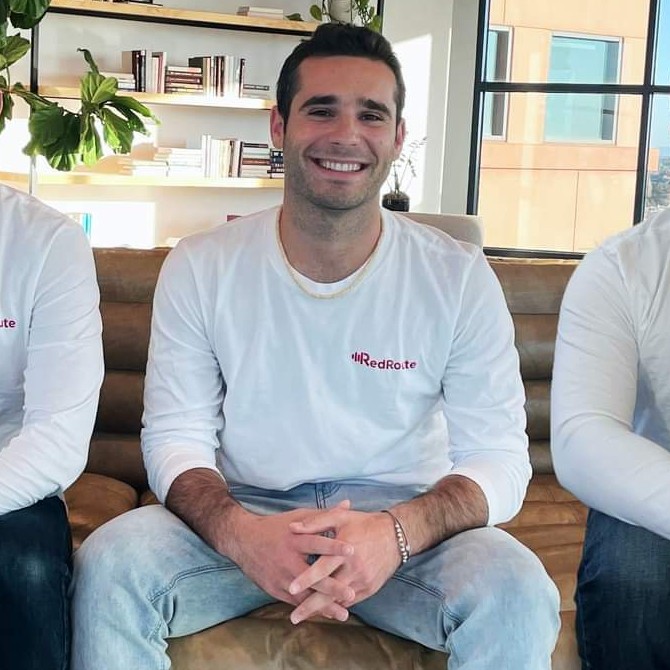
Brian Schiff
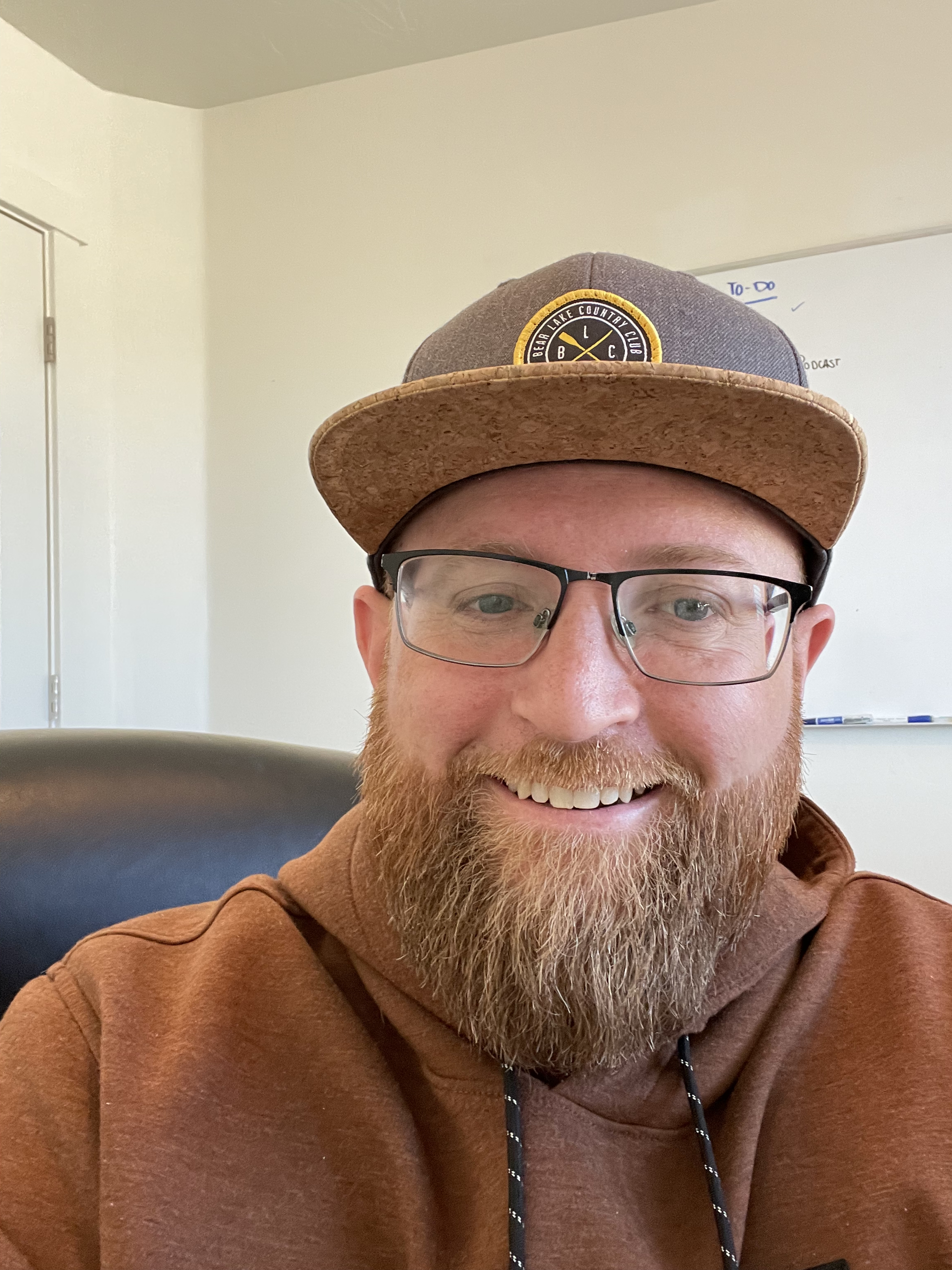
James Gilbert
Today's Guests


